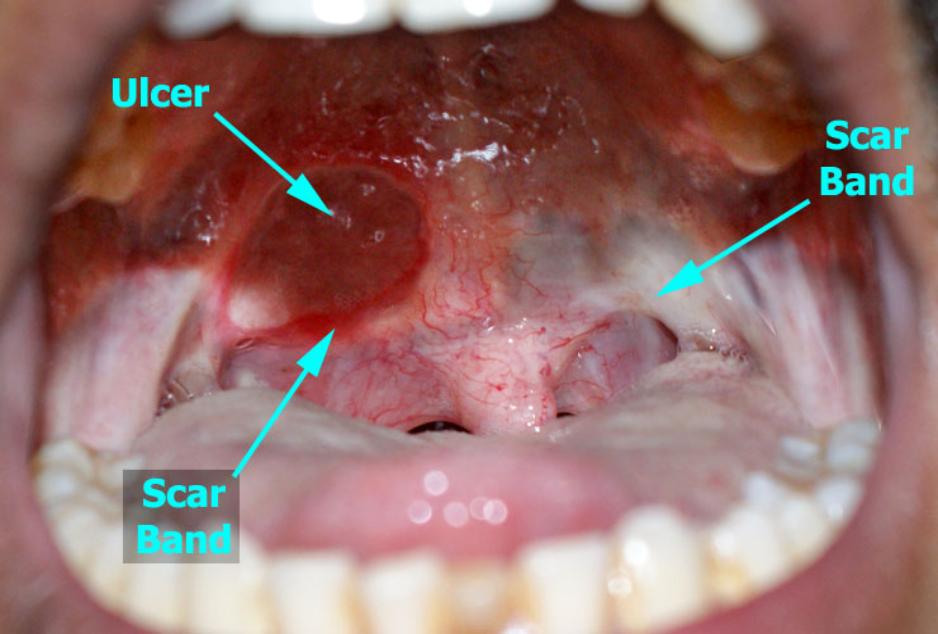Oral Sub-Mucous Fibrosis
Oral Sub-mucous Fibrosis (OSF) is a well-recognised oral pre-cancerous condition, observed predominantly in populations of South Asian ethnic origin. It predominantly occurs in the Indian sub-continent and people of South Asian ethnicity living in other countries such as the UK, Singapore and Malaysia, among others.
It is characterised by a unique generalised fibrosis (scarring) of the sub-mucosal oral soft tissues, resulting in marked rigidity of the oral mucosa leading to progressive trismus (inability to open the mouth), rigidity of lips and difficulty in protruding the tongue.
Ætio-Pathogenesis:
Risk Factors:
- areca nut chewing ± tobacco
- capsaicin in chilies and
- micro-nutrient deficiencies of iron, zinc and essential vitamins.
An increase in the frequency of this disease, especially among the young, has been reported in India due to the increase in the use of commercially prepared areca nut preparations without betel leaf (pan masala).
A genetic predisposition for the development of this disease has also been reported.
The areca nut, which contains alkaloids such as arecoline, and other chemicals, such as catechin and tannin, plays a major role by stimulating production of collagen fibres and making them less susceptible to the action of collagenase (an enzyme that breaks down collagen).
It is suggested that components of the areca nut also affect gene expression in the fibroblasts leading to the production of greater amounts of normal collagen. Areca nut has been shown to have a high copper content, and chewing areca nuts for 5 – 30 minutes significantly increases soluble copper levels in oral fluids. This increased level of soluble copper supports the hypothesis that copper acts as an initiating factor in OSF by stimulating fibrogenesis.
It is not clear if a hypersensitivity reaction to chillies plays any role in the development of OSF.
leading to deranged repair processes of the inflamed oral mucosa, contributing to defective healing and scarring.
Iron deficiency anæmia, vitamin B complex deficiency and malnutrition are implicated in the development of OSF leading to deranged repair processes of the inflamed oral mucosa, contributing to defective healing and scarring.
The resulting atrophic oral mucosa is more susceptible to the effects of areca nut and alcohol. An immunological process and a genetic component are assumed to be involved because of reported cases in non–areca nut chewers. Increased levels of pro-inflammatory cytokines and reduced anti-fibrotic interferon have also been demonstrated in patients with OSF.
Clinical Features:
Clinically, patients present with a lustre-less, marble-like blanching of the oral mucosa.
In the early stages, features of stomatitis such as erythematous (reddened) mucosa, vesicles (blisters), mucosal ulcers, blotchy melanotic mucosal pigmentation (like freckles) and mucosal petechiæ (bruising) may be observed.
peri-commissural area. A mottled, marble-like appearance may be evident due to the bands running in the blanched mucosa.
In advanced disease, there is trismus, sinking of the cheeks out of proportion to age, stiff and small depapillated tongue, blanched floor of mouth, fibrotic (scarred) gingival tissues, stiff soft palate with reduced mobility and shrunken bud-like uvula and blanched and atrophic tonsils.
> 25% of affected persons may have co-existing leukoplakia. The buccal mucosa is the most commonly involved site, followed by the lip and tongue but OSF can occur in any intra-oral site.
The frequency of malignant transformation in OSF has been reported to be in the range of 7 – 13%. Whether the malignant transformation is more common in leukoplakic areas than non-leukoplakic areas in patients with OSF is not clear.
A clinical diagnosis of OSF is made based on the symptoms and clinical features described above. A biopsy should be taken to confirm the diagnosis and to rule out dysplasia and malignancy.
Management
- Cessation of habits
- Correction of nutritional deficiency
- Mouth opening exercise
- Oral lycopene (anti-oxidant found in tomatoes)
- Sub-mucosal injections of steroids, hyaluronidase, collagenase & placental extract
- Surgical removal of fibrous tissues & use of tissue grafts
The treatment of patients with OSF depends on the degree of clinical involvement.
If the disease is detected at a very early stage, cessation of the habit is effective. However, it is often irreversible in OSF patients who present with severe disease.
The focus of treatment should be on reducing exposure to the risk factors, especially the use of betel quid and correcting any nutritional deficiencies, such as iron and vitamin B complex and on regular mouth opening exercises.
Muscle stretching exercises for the mouth may be helpful to prevent further limitation of the mouth opening.
Sub-mucosal injections of agents such as dexamethasone, hyaluronidase, placentral extracts and collagenase have been tried with some benefit in symptomatic improvement.
Excision of the fibrous tissues, with correction of the defect using various grafts especially with buccal fat pad graft, has been tried in patients with severe OSF.
Lycopene has been shown to be of some benefit.
In general, there is no effective treatment for OSF and the condition is irreversible once fibrosis sets in. Even though several treatment regimens have been tried with varying success, so far no effective treatment is available for OSF.
Useful Articles & Websites
New Zealand Dermatological Society (DermNZ)
International Agency for Research on Cancer / World Health Organisation
Cochrane Review 2008. Interventions for the Management of Oral Sub-Mucous Fibrosis
J Oral Maxillofac Surg 2009. Drug Treatment of Oral Sub-Mucous Fibrosis – A Review of the Literature
BJOMS 2009. Extended Naso-Labial Flaps in the Management of Oral Sub-Mucous Fibrosis
Evidence-Based Dentistry 2009. Lack of Reliable Evidence for Oral Submucous Fibrosis Treatments
Evidence-Based Dentistry 2010. Drug Treatment for Oral Submucous Fibrosis
JOMS 2011. Use of Buccal Fat Pad for Treatment of Oral Submucous Fibrosis




